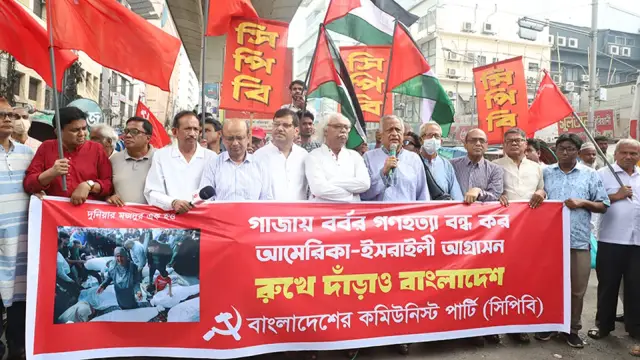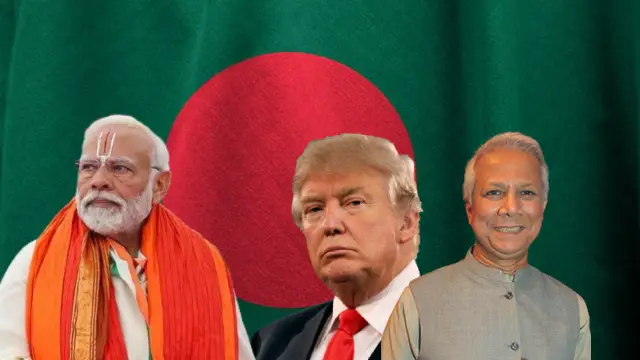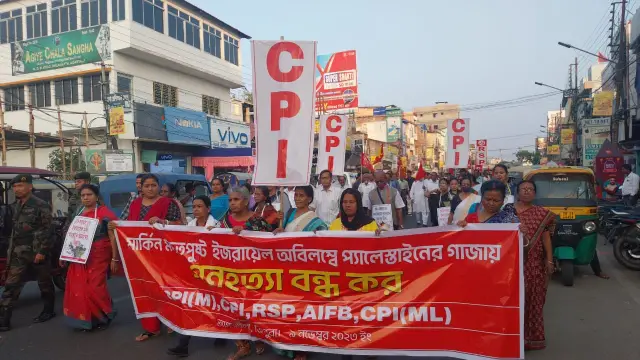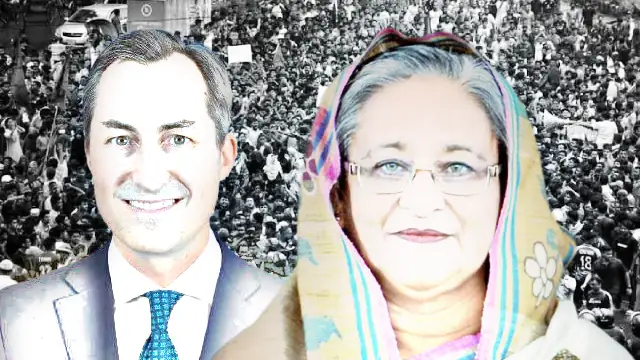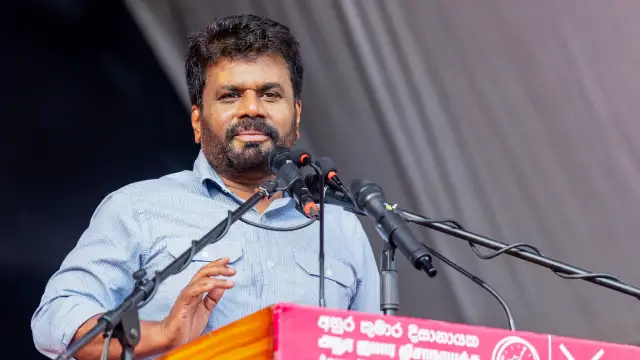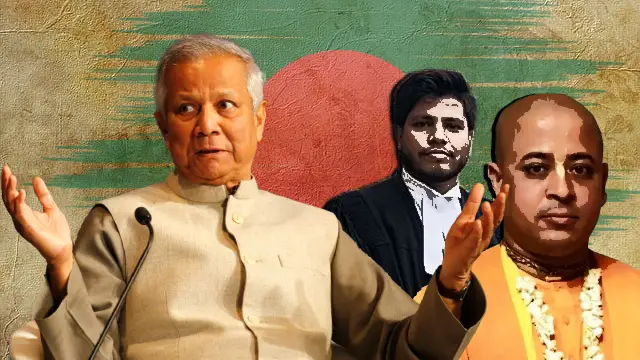A patch of gloomy clouds may have hovered over Chattogram (Chittagong), nestled in the cosy blanket of serene nature this monsoon. Following Sheikh Hasina’s fall, incidents of minority repression in Bangladesh—specifically attacks on Bangladeshi Hindus, Buddhists, and Christians—have allegedly increased manifold, or so claims neighbouring India’s mainstream media. But what is the truth?
Chittagong: The epicentre of minority repression in Bangladesh
While many of his fellow Hindus are staging protests in Dhaka’s iconic Shahbagh Square, demanding protection for the largest minority community in the South Asian country, Sajib Nath, a young man from Chittagong’s Anwara Upazila, is busy preventing untoward incidents and protecting minority places of worship.
He is part of a network of young volunteers who have taken it upon themselves to help restore order in Bangladesh.
When asked about his experience amid the allegations of minority repression in Bangladesh, Mr Nath told the East Post that except for a few isolated incidents, nothing major happened in his area.
Media reports claim there eight were killed in Chittagong as a result of minority repression in Bangladesh. Chittagong not only experiences attacks on Bangladeshi Hindus but also on Buddhists and Christians alike.
Mr Nath claims that since August 5th, he and the local youth have been working diligently to maintain peace in the region, ensuring that each union or ward is watched, particularly at night.
“Yes, people are safe. There’s no problem here for now. If any issues arise, our team steps in to help,” Mr Nath told the East Post.
When questioned about robberies and attacks on Bangladeshi Hindus, Mr Nath responded, “There was no such incident, but there was an attempt to forcibly seize one of our temples after the fall of the government. However, we managed to chase the miscreants away with the help of the Army.”
However, he added that minority identity was not the only reason for the attacks on Hindus in Chittagong.
“There were political reasons and ongoing conflicts in places like Roujan, which saw the most attacks on homes. All of these were politically motivated, even though the areas were minority-dominated. In some places, security was ensured by the intervention of the Army, while in others, locals and volunteers put up resistance, responding immediately to any threats,” said Chittagong resident and student volunteer Adil Raihan.
“I have heard of attacks on Hindus outside Chittagong, particularly towards North Bengal, which were based on religious identity. In some cases, I have found this to be true,” Mr Raihan told the East Post.
These young volunteers are protecting people in the absence of police, keeping Bengali nationalism alive, and fighting communalism with little more than their bare hands.
“There are roughly a thousand volunteers. Initially, whenever we heard of an attack anywhere, we would rush to the site with friends and try to repel it. At first, we would guard the temples or risk zones in Central Chittagong at night. Now, with the rise in extortion, I am working to address it. Besides, if there is an attack anywhere, I am involved in providing instant responses, such as bringing in the Army if there’s a possibility of a significant attack. We have also organised area-based patrols to address threats to anyone’s home,” Mr Raihan added.
A local of Chittagong, Samin Yaseer Saad, told the East Post that on August 5th and 6th, there were many incidents of attacks and intimidation targeting minorities. However, he believes that the deposed ruling party was behind these attacks.
“Since we are in an urban area, there have been isolated lootings, but minorities have not been attacked en masse. To say there were no attacks would be incorrect; they did happen in some places, but not due to minority identity. At that time, many Awami League members’ homes were attacked, which is why these incidents occurred. The most significant attacks happened on August 5th. However, since August 6th, there has been a rise in intimidation and isolated attacks in various locations. We have come to know from leaked conversations that Bangladesh Chhatra League (BCL) members stationed in the area orchestrated these incidents,” Mr Saad said.
BCL is the controversial student wing of the now-deposed Awami League. It has been accused of running a reign of tyranny on campuses across the country for over 15 years. The Chhatra Dal (CD) is affiliated with the main opposition Bangladesh Nationalist Party (BNP).
“Temple-to-temple patrolling was initiated as there were reports of temple attacks in some parts of the country. Additionally, the students were constantly informed by the Army about potential attacks, prompting swift responses,” says Mr Saad.
But others highlight minority repression in Bangladesh
While the young men and women who are part of the vigil to protect the country praise the Army for its proactive role in maintaining law and order, Rana Dasgupta, the chief of the Bangladesh Hindu Buddhist Christian Unity Council (BHBCOP), offers a different perspective.
Mr Dasgupta claims that over 205 incidents of minority repression in Bangladesh occurred between August 5th and August 9th. In a press briefing on August 10th, the leader, whose organisation is alleged to be close to the former dispensation, stated that Hindus and other minorities would intensify their movement if the interim government under Mohammad Yunus does not accept their demands for a minority ministry, minority representation, the recovery of their lost properties, and security coverage.
However, not all Bangladeshi Hindus share his views. Individuals like Arup Roy and Prem Paul in Habiganj, Tapos Kumar in Narail, and Biplob Kumar in Satkhira, among many others, remained committed to protecting law and order themselves when the police went on strike from August 5th to August 9th, leaving the people vulnerable to attacks from miscreants.
While many Bangladeshi Hindus have attempted to enter India, particularly from northern Bangladesh to the Cooch Behar district of West Bengal, the Border Security Force (BSF) has successfully prevented them from crossing the border.
Interestingly, many of those attempting to cross are found to be Muslims who were activists of Sheikh Hasina’s Awami League. For instance, Abdul Qadir, a former leader of BCL, fled his home in Narayanganj and travelled 260 km to Chapainawabganj, from where he attempted to enter India. However, the BSF’s 15th Battalion apprehended him at the Pirojpur Char village of Bahura on Sunday, according to the paramilitary force.
Several hundred people stranded at the borders in Cooch Behar were deterred by the BSF, even when they raised the “Jai Shri Ram” slogan, used by India’s ruling Bharatiya Janata Party (BJP). This slogan has been chanted by Shahbagh protesters, about which Mr Dasgupta remained silent when questioned.
Political experts suggest that the optics of minority repression in Bangladesh could benefit Indian Prime Minister Narendra Modi’s BJP, which faced setbacks in the last Lok Sabha elections, particularly in the upcoming elections in Haryana, Maharashtra, Jharkhand and Delhi.
Bangladesh Hindu resistance leader Gobinda Pramanik debunks Indian media’s propaganda on minority repression in Bangladesh. Mr Pramanik, perceived close to the Hindutva camp in Bangladesh, alleged that attacks on Awami League workers are shown as attacks on Bangladeshi Hindus by Indian media.
Far-right Islamist terror organisation Jamat-e-Islami, accused of aiding Pakistani atrocities in 1971, also showed concern for Hindus and marched to temples. Their leaders also blamed the deposed Awami League for the attacks.
In his greeting message to Mr Yunus, Mr Modi expressed concern about attacks on Bangladeshi Hindus, though he refrained from mentioning Buddhists and Christians, or the overall minority repression in Bangladesh.
Brahmanbaria—An oasis of harmony?
Sporadic incidents of clashes in Brahmanbaria, over football matches, the FIFA World Cup, gambling, the rules of offering the Muslim prayer called namaz and other trivial or international affairs are common and they cause several casualties.
Ironically, it’s not the same case this time. Brahmonbaria appears as an oasis in a turbulent Bangladesh.
Apart from a minor incident, nothing significant has occurred, according to youth volunteers working tirelessly to maintain peace in the region during the police’s absence. “There has been no trouble so far,” Mirazul Haque, a resident of Brahmanbaria’s Paikpara area, told the East Post. “However, a group of people tried to use this chaotic period to resurrect a four-to-five-year-old land dispute, but our team intervened and prevented it,” says Mr Haque.
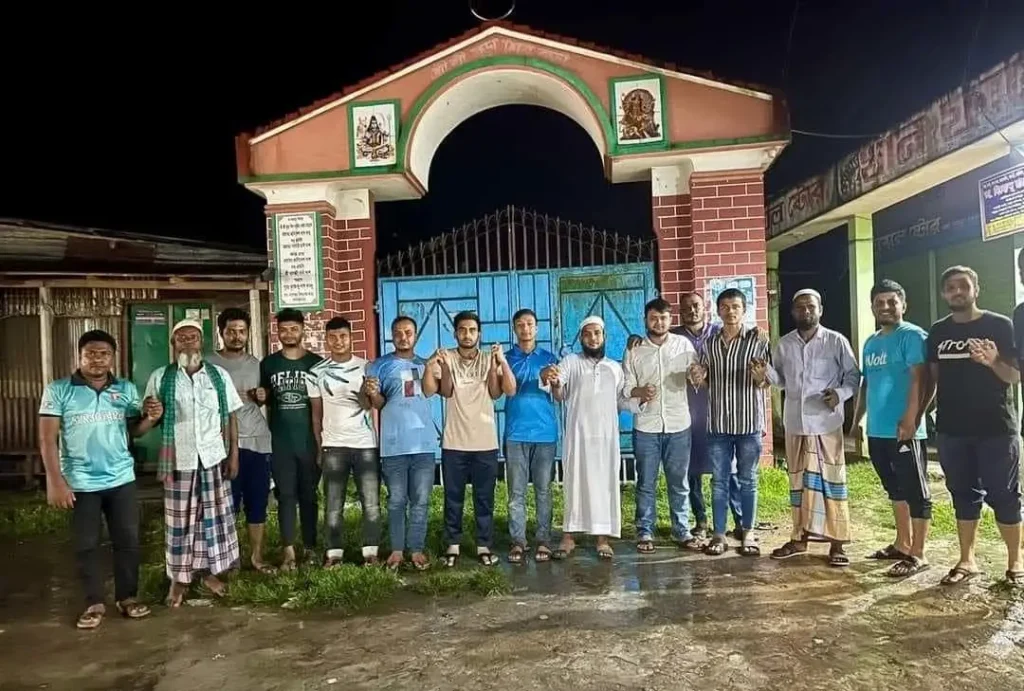
He explained that the land dispute was old, but efforts were being made to revive it. He insists that the area’s residents have remained safe, with volunteers keeping watch, even as the police didn’t return to the station until August 9th. He also mentioned that people have been receiving support from volunteers via helplines.
“On August 7th, a woman looking for her brother called at 3am. Within 15 minutes, I assured her that her brother was safe, and I connected them in the morning,” Mr Haque said, highlighting the volunteers’ dedication.
Md Wali Ullah, a student of North-South University, has been working hard to maintain peace and order in Brahmanbaria’s Sarkar Para area. Although initially hesitant to speak to the East Post, Mr Wali Ullah later shared, “Since the resignation of the former prime minister, nothing has happened anywhere in Brahmanbaria.” He added, “We, the students, have been working as a team on the streets to ensure there is no danger anywhere.” Many students have joined them to manage traffic and address other concerns. Along with support from the Bangladesh National Cadet Corps (BNCC) and Scouts, they formed two teams after Sheikh Hasina’s fall, comprising non-sectarian student groups. These teams are ready to prevent minority persecution and ensure that no temple or church is attacked. He noted that their phone number has been widely shared on social media so that anyone in need can call for assistance.
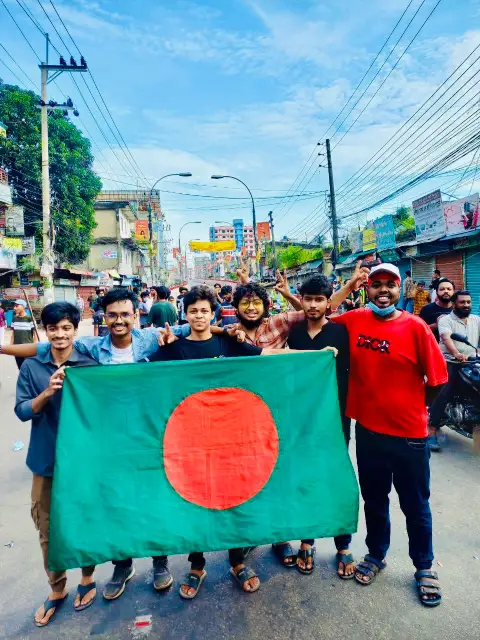
Mr Wali Ullah is also aware of the dispute regarding the land of Paikpara temple. He said that the dispute started of old enmity, as someone attempted to encroach on the temple’s land to widen a road. He and his team not only dissuaded them but also brought in a lawyer to explain the legal repercussions the accused would face if they proceeded with such an attempt in the future.
Quietness in Barisal
Nahian Shafiq, a resident of Barisal’s Gournadi Upazila and a young volunteer, told the East Post that no minorities were attacked in their area. “We are guarding the religious establishments of the minorities with the help of the public at night. But no serious attack has been reported since the night of August 5th. I see many madrasa students here in Bangladesh guarding the temple and ensuring peace,” said Mr Shafiq.
However, Bangladeshi media refutes the claim of complete quietness in Barisal, while ruling out incidents with a communal tinge. According to The Business Standard, “Three families in Jhalakathi, two in Patuakhali, one in Bhola’s Tajumaddin, two in Pirojpur, and two in Barisal city have reportedly been attacked since August 5th.”
The report adds that most of the victim families were affiliated with Awami League politics, and the attacks were driven by local disputes and previous enmity, exacerbated by recent political changes. However, no incidents of attacks fuelled by sheer bigotry or a fundamentalist-driven campaign have been reported in Barisal, according to student activists. The Army also did not report any such incidents taking place in Barisal.
Dhaka: The capital’s dichotomy
Dhaka is experiencing large-scale agitation against Mr Yunus’s interim government, led by those who claim to be victims of minority repression in Bangladesh. Amid the movement staged by BHBCOP, the Puja Udjapan Committee, and the Minorities Unity Forum, activists on the ground have contrasting accounts of the situation.
The situation in the capital, Dhaka, worsened on and before August 5th due to various clashes between BCL miscreants and the youth crowd. However, before Ms Hasina left Dhaka on August 5th, Awami League workers, irrespective of their religious identity, fled from various localities, fearing the wrath of the people.
Kazi Maitri, who knows Mohammadpur in the capital Dhaka like the back of his hand, showed the East Post how the central area of Mohammadpur is its heart. This area consists of Taj Mahal Road, Aurangzeb Road, Noorjahan Road, Razia Sultana Road, Salimullah Road, Shahjahan Road, Babar Road, Humayun Road, Sher Shah Shuri Road, and Azam Road. All the settlements in these areas are gated communities, resulting in high security.
“Two notable structures in this area are the Bansbari Durga temple and the ward councillor’s building. The skirmish that has taken place in this area in the last two days is mainly because of the Awami League in front of the ward commissioner’s building. But the local Hindus are afraid because the temple is also in the same area, and the number of Hindus in Mohammadpur is very small,” Mr Maitri highlighted.
Mr Maitri asserts that the protection of minorities is being regularly handled by volunteers. “It is to be noted that people feared religious unrest due to tension and political clashes near the temple from this area, but nothing happened. We have kept watch for four nights so far. The first two nights were hectic, but the next two nights were very festive, and everyone left the house with joy and played cricket in the streets. Now the night guard is almost entirely in the hands of madrasa students, who wear a uniform—white punjabi (kurta) and caps—with ID cards and sticks in their hands,” Mr Maitri informed.
Giving details about the vigil, he said that the volunteer alliance of Mohammadpur consists of youths from the Mohammadi Youth Club, security guards of the local welfare society, and students from three nearby madrasas who have joined them.
“Organised groups include fire volunteers, ham radio groups, and scout groups (they don’t keep watch at night),” he said.
According to him, Mohammadpur is completely normal. However, it will take time for the affected areas to normalise. “There are very few minorities in the Mohammadpur area; those who are there are doing well, but minorities are definitely facing problems in marginal areas like Panchagarh. No one will harm Hindus in Dhaka city; no church will be burnt,” asserts Mr Maitri.
Md Asifuzzaman, a student of Dhaka University, is playing the role of a volunteer in the Rampura, Khilgaon, and Banasree areas of the capital. He told the East Post that the unrest that started in his area on August 5th was mainly an attack on a police station and looting. He said a temple in the vicinity was attacked at that time. He claimed that the attack on it was part of the attack on the police station. However, Mr Asifuzzaman claims that they, the volunteers, have increased patrolling since the incident and work to restore peace in the entire region.
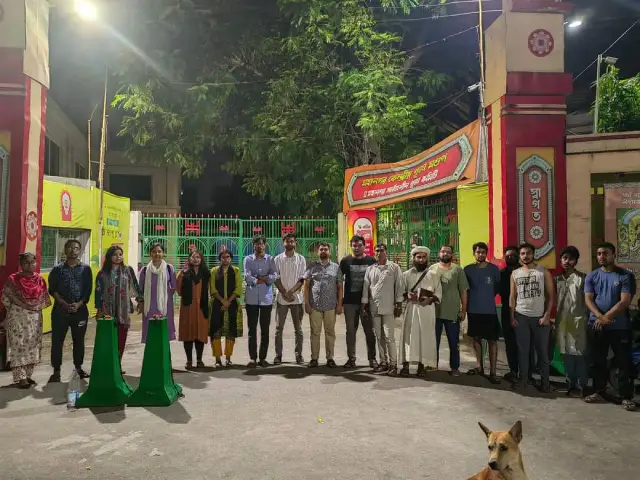
Mr Asifuzzaman informed the East Post that he sent a team of 22 people during police raids in the area, and then the situation came under control. At that time, shops of both Hindu and Muslim communities were vandalised near the temple and police station in the region, he said.
“If I talk about minority persecution, then it is part of a propaganda campaign to implement ‘divide and rule’ in Bangladesh. Some of those who were part of the Awami League of Bangladesh are attacking all these places, and it is the people of Bangladesh who think that it is propaganda by the Awami League. Apart from that, most of the rumours and fake news are being spread by editing pictures or reproducing videos of old events as current,” said Riasat Amin, a climate and flood expert who volunteers in Dhaka’s Khilgaon area.
Mr Amin says that he is a member of a volunteer group called ‘Save the Temple’, which rushes to the spot to monitor whenever any untoward incident occurs in a temple or when someone calls them to report. “It is not that some incidents are not happening, but they are happening as part of the ‘divide and rule’ policy to prove that minorities will not be better off without Awami League rule,” said Mr Amin.
Sakir of Dhaka’s Mirpur, who did not give his surname, guards minority religious sites with his friends and told East Post that they have not had any problems there. He claimed that people are safe in Mirpur.
Fahim, another youth from Mirpur, said, “Aware students are in the field to help the minorities. We are working day and night to keep the situation favourable. Students will not allow these minorities to be oppressed, even if someone wants to. And miscreants are spreading pictures or videos of different times to spread rumours. It would not be right to deny that nothing is happening, but the people of our area are quite conscious.”
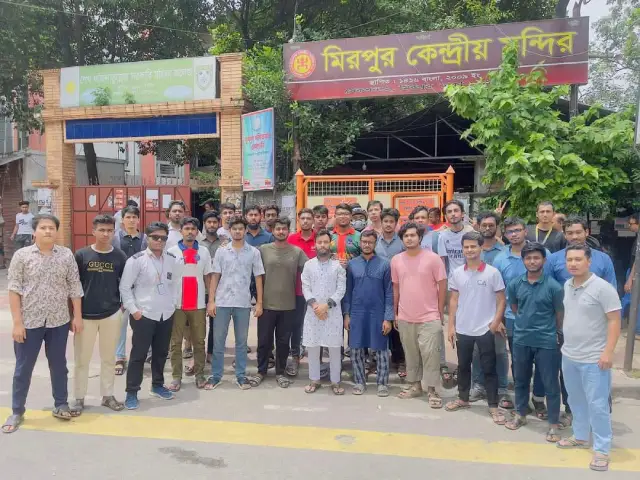
When asked how they are dealing with all these incidents, he said, “We students are trying to work by forming area-based committees! From ensuring security to normalising the places where any unusual events are currently taking place.”
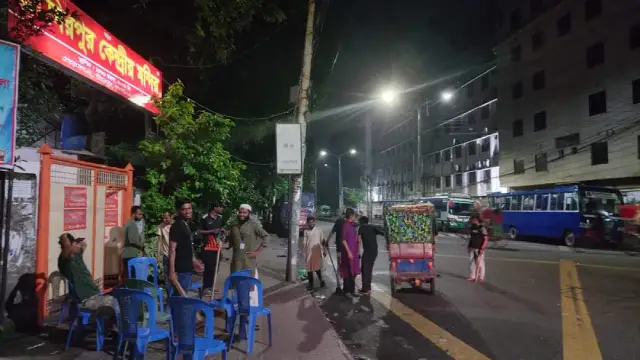
In Savar, the Amra Savarbasi team has also been vigilant for the safety of minorities since the beginning. The team’s spokesperson told East Post, “There was some trouble on August 5th, but Savar is the only place where no communal incident happened. We have done our utmost to ensure the safety of our Sanatan brothers from the beginning.”
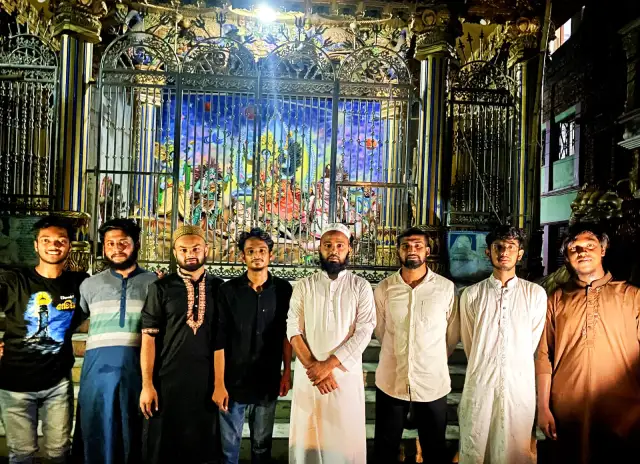
Tanveer Imtiaz Atul of Jagannath University said, “I have not received any news of temple vandalism in Dhaka so far. All of us here are guarding the temple wherever possible. The perpetrators have not left; they are somewhere. They do not belong to any religion; they are destroying temples as well as Islamic mazars, sculptures, and murals. They are people who do not follow the path of God. Educated society condemns them. Outside Dhaka, the picture is a little different, where we hear of attacks on some temples. But the Army is covering all the areas as fast as possible and arresting these miscreants.”
Habiganj protects minorities too
Hossain Ahmed Sagor, the director of an IELTS academy called Praxis Habiganj, stated that there had been no incidents of attacks on minorities in his area. Mr Sagor mentioned that they are regularly guarding the area, with students watching over minority places of worship every night. No untoward incidents have occurred as a result. “We are our brothers’ guard. We will take the blow first, then they [minorities],” asserted Mr Sagor.
Sourav Ahmed of Habiganj told the East Post, “There was no attack on minorities. The attack took place only at the residence of the local MP and the mayor.” Dismissing any incident of communal violence, Mr Ahmed said that the students there remain vigilant. “Students guarded the temple at night,” he added.
Gaibandha’s tale
“Our district is currently very peaceful; everyone is getting along, and there is no riot or anger among anyone! There have been reports of untoward incidents in different parts of the country, but there have been no such reports in our district so far,” said Farhan Sadiq, a resident of Gaibandha in North Bengal, to East Post.
Mr Sadiq mentioned that students in various areas of Gaibandha are forming groups to stay with the people and protect the security of the area. He attributes some sporadic incidents to the absence of the police and administration but is hopeful of a quick resolution as the police start returning to their posts.
Attacks on Bangladeshi Hindus and the promise of a new land
Minority repression in Bangladesh, particularly the attacks on Bangladeshi Hindus, intensified on August 5th and 6th but were eventually subdued by student vigils and Army patrols. These efforts prevented further violence, though the underlying tensions remain.
The situation has led to widespread grievances against the ousted Awami League, with reports of Hindus linked to the party being involved in provocations.
In a viral Facebook Live, it’s shown a group of 10 Hindus, allegedly associated with Awami League, were nabbed while they tried to attack a temple in Rajarhat of Kurigram.
Allegations persist that these incidents are fuelling India’s ruling BJP’s Hindutva agenda.
As the new government stabilises, students continue to address the aftermath, but concerns about the nation’s future linger, especially among minorities.
The youth, however, remain committed to defending the hard-won freedom of Bangladesh. They claim they will build a state that will prevent attacks on Bangladeshi Hindus or the overall minority repression in Bangladesh.
Tanmoy Ibrahim is a journalist who writes extensively on geopolitics and political economy. During his two-decade-long career, he has written extensively on the economic aspects behind the rise of the ultra-right forces and communalism in India. A life-long student of the dynamic praxis of geopolitics, he emphasises the need for a multipolar world with multilateral ties for a peaceful future for all.

